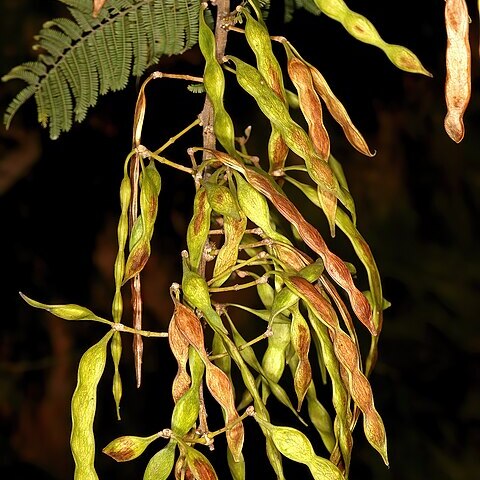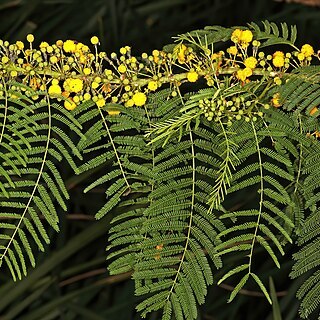Shrub or small tree up to 5 m high. Bark yellow to yellowish-brown or brown, soft, corky, sometimes slightly papery, fissured; young branchlets creamy-white or yellowish to pale grey-brown or brown, glabrous to puberulous. Stipules spinescent, in pairs, 0.4-3 cm long, straight, slender, mostly ascending, glabrous or densely puberulous; other prickles absent. Leaves: petiole 0.3-0.9 cm long, glabrous to densely puberulous, adaxial gland often absent, when present usually just below the lowest pinna pair; rhachis (3.6)8-14(18) cm long, glabrous to densely puberulous, with a gland at the junction of the top 1-6 pinnae pairs; pinnae of well-developed leaves in 12-27 pairs (reduced leaves with as few as 8 pairs of pinnae sometimes also present); rhachillae 1.8-4.4(5.6) cm long; leaflets (17)20-36(44) pairs per pinna, 1.9-6 x 0.6-1 mm, linear to linear-oblong, apex obtuse to subacute but not spinulose-mucronate, eglandular, margins glabrous or occasionally with few short cilia, usually glabrous below. Inflorescences capitate, on axillary peduncles, fascicled, borne along shoots of the current season and often aggregated into ± elongate terminal 'racemes'. Flowers bright-yellow, sessile; peduncles 0.8-3(6) cm long, glabrous to densely puberulous; involucel |-f-way up the peduncle. Calyx glabrous except for pubescence on the lobes, especially apically, or sparingly puberulous throughout, tube 0.9-1.4 mm long, lobes up to 0.4 mm long. Corolla glabrous, tube 1.4-1.9 mm long, lobes up to 0.6 mm long. Stamen-filaments free, up to 4 mm long; anthers with a deciduous apical gland. Ovary up to 1.75 mm long, glabrous. Pods pale to dark yellowish-brown or brown, (5)7-12(17) x 0.5-0.8 cm, linear, straight to slightly falcate, longitudinally dehiscent, not or somewhat constricted between the seeds, glabrous to sparingly puberulous, eglandular, flat, inconspicuously venose, sometimes irregularly swollen and pustulate from insect attack. Seeds olive-to dark-brown, 6-7.5 x 3-5.5 mm, elliptic, compressed; areole 4-5 x 2.5-3.5 mm.
More
Small tree or shrub, up to 5 m high. Bark on trunk and branches usually corky. Leaves well developed, with 12-27 pinnae pairs; leaflets 20-44 pairs per pinna, up to 1 mm wide. Pods straight or slightly curved, 5-8 mm wide, eglandular. Flowers bright yellow.



